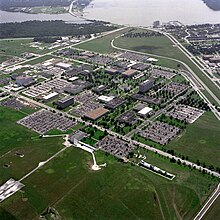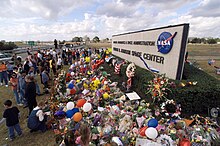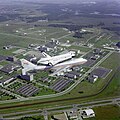Lyndon B. Johnson Space Center
The center, originally known as the
Manned Spacecraft Center, was constructed on land donated by
Rice University and opened in 1963. On February 19, 1973, the center was renamed in honor of the late U.S. president and Texas native,
Lyndon B. Johnson.
[2] JSC is one of ten major NASA field centers.
[edit] History

Flight controllers celebrate the
Apollo 13 splashdown April 17, 1970;
Gerry Griffin (l) became JSC director in 1982.
Johnson Space Center has its origins in legislation shepherded to enactment in 1958 by then-
U.S. Senator Lyndon Johnson. After President
John F. Kennedy made the goal in 1961 to put a man on the
Moon by the end of the decade, the
Space Task Group was formed with
Langley Research Center engineers to lead the
Apollo Project.
[3] The group would need test facilities and research laboratories suitable to mount an expedition to the moon. In July 1961, NASA Administrator
James E. Webb headed the site selection team. Requirements for the new site included the availability of
water transport and an all-weather airport, proximity to a major telecommunications network, availability of established industrial workers and contractor support, an available supply of water, a mild climate permitting year-round outdoor work and a culturally attractive community. Houston was initially included because of the proximity to the 4,700-acre (19 km
2)
United States Army San Jacinto
Ordnance Depot located on the
Houston Ship Channel, and to regional universities, including
Rice University,
University of Texas, and
Texas A&M University.
[3] The selection of Houston for the site was announced in September 1961. The land for the new facility was donated by Rice University and was situated in an undeveloped area 25 miles (40 km) southeast of Houston near
Galveston Bay.
[4][5] Construction of the center, designed by
Charles Luckman, began in April 1962, and the facility was officially opened for business in September 1963.
[6][7] When opened, the 1,620-acre (660 ha) facility was originally designated the Manned Spacecraft Center (MSC) and was to be the primary center for U.S. space missions involving astronauts.
[4][5]The center's Mission Control Center has been the operational center of every American human space mission since
Gemini IV. The control center manages all activity on board the spacecraft and directs all space shuttle missions. Mission Control Center was constructed in 1962.
[3] By 1965, JSC was fully operational and has been responsible for coordinating and monitoring every crewed NASA mission since the
Gemini Project.
In addition to housing NASA's astronaut operations, JSC is also the site of the former
Lunar Receiving Laboratory, where the first astronauts returning from the
moon were
quarantined, and where the majority of
lunar samples are stored. The center's Landing and Recovery Division operated
MV Retriever in the Gulf of Mexico for Gemini and Apollo astronauts to practice water egress after
splashdown.
In the wake of the January 28th, 1986
Space Shuttle Challenger disaster, then-President Ronald Reagan and First Lady Nancy traveled to JSC on January 31 to speak at a memorial service honoring the astronauts. It was attended by 6,000 NASA employees and 4,000 guests, as well as by the families of the crew. During the ceremony, an Air Force band led the singing of "God Bless America" as NASA
T-38 Talon supersonic jets flew directly over the scene, in the traditional
missing-man formation. All activities were broadcast live by the national television and radio networks.
One of the artifacts displayed at Johnson Space Center is the
Saturn V rocket. It is whole, except for the ring between the
S-IC and S-II stages, and the fairing between the S-II and
S-IVB stages, and made of actual surplus flight-ready articles. It also has a real (though incomplete)
Apollo CSM, intended to fly in the canceled
Apollo 19 mission.
In September 2008, NASA's Johnson Space Center celebrated its 50th year of leading America into space.
[8]On April 20, 2007 a
hostage situation developed in Building 44, the Communication and Tracking Development Laboratory where a gunman killed one person, injured another, and took a hostage for over three hours until finally committing suicide.
On September 13, 2008
Hurricane Ike hit
Galveston as a Category 3 Hurricane and caused minor damage to the Mission Control center and other buildings in the Johnson Space Center.
[9] The storm damaged the roofs of several hangars for the
T-38 Talons at Ellington Field.
[9][edit] Facilities
The Johnson Space Center is home to
Mission Control Center (MCC-H), the NASA control center that coordinates and monitors all human spaceflight for the United States. MCC-H directs all
Space Shuttle missions and activities aboard the
International Space Station. The
Apollo Mission Control Center, a
National Historic Landmark can be found in building 30. From the moment a spacecraft clears its launch tower until it lands back on earth, it is in the hands of Mission Control. The Mission Control Center houses several Flight Control Rooms, from which
Flight controllers coordinate and monitor the spaceflights. The rooms have many computer resources to monitor, command and communicate with spacecraft. When a mission is underway the rooms are staffed around the clock, usually in 3 shifts.
The center handles most of the planning and training of the US astronaut corps and houses training facilities such as the
Sonny Carter Training Facility and the
Neutral Buoyancy Laboratory, which is a critical component in the training of astronauts for spacewalks. The Neutral Buoyancy Laboratory provides a controlled neutral
buoyancy environment a very large pool containing about 6.2 million US gallons (23,000 m³) of water where astronauts train to practice
extra-vehicular activity tasks while attempting to simulate
zero-g conditions.
[10][11] The facility provides pre-flight training in becoming familiar with crew activities and with the dynamics of body motion under weightless conditions.
[12]The visitor's center of Johnson Space Center is
Space Center Houston since 1994. One of the JSC buildings (Building 2) once housed the JSC Visitor's Center.
The Johnson Space Center Heliport (
FAA LID:
72TX) is located on the campus. Ronald C. Bailey manages the
heliport.
[13]
| Space Shuttle Challenger, atop its Boeing 747 SCA, flying over JSC. | Astronaut photograph centred on the JSC. |







